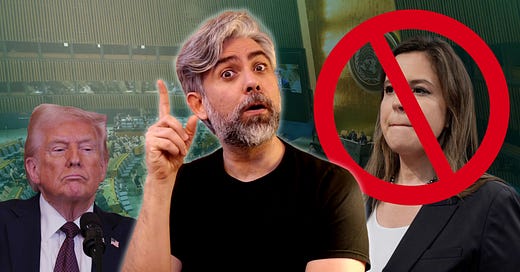Elise Stefanik, once considered a front-runner for Donald Trump’s vice presidential slot and more recently tapped as the next U.S. Ambassador to the United Nations, has been asked to withdraw from the nomination. The directive came directly from Donald Trump, urging her to return to the House of Representatives — a move that has left many observers puzzled, especially since Stefanik had already begun a farewell tour of her district.
This surprise reversal raises questions about the strategic reasoning behind Trump’s decision. The timing, the political stakes, and the looming legislative calendar all appear to be key components in a much larger game of congressional chess.
A central concern appears to be a special election in Florida. Polling data from Fabrizio Ward — helmed by Trump’s trusted pollster Tony Fabrizio — shows the Republican candidate with only a three-point lead in a district that Trump carried by 30 points in the last election. The narrowing margin is attributed not just to candidate quality, but also a significant financial disparity: Democrats have outspent Republicans by over $8 million. This disparity has translated into heavier air traffic and visibility for the Democratic challenger.
Speculation suggests Trump may be trying to protect the Republican majority in the House, fearing it could be further weakened by Stefanik’s departure. But some political watchers — myself included — argue that this explanation is too simplistic and out of step with Trump’s usual political instincts.
A more intricate and possibly more compelling reason involves legislative mechanics in New York. Stefanik has not officially resigned from the House. If she had, Governor Kathy Hochul — who, as a Democrat, has little incentive to rush — would have 90 days to call a special election. Starting that clock now would push any vote into late June, possibly beyond the key reconciliation package deadline. That seat, currently held by Stefanik, could be unavailable during crucial legislative moments.
Further complicating the issue, a proposed bill in the New York State legislature would allow the governor to delay special elections until the next general election. If passed, this would effectively remove Stefanik’s seat from the House until 2026, robbing Republicans of a vote not only for the rest of this year but most of next year as well.
This development underscores how thin the Republican majority truly is. Stefanik stepping away — even temporarily — represents a potentially significant loss in the vote count. With both the House and Senate reportedly aligning this week on legislative priorities, every vote counts more than ever.
Stefanik, having exited Republican leadership and publicly prepared for her transition to the UN role, now finds herself in a politically awkward position. She will likely need a face-saving path back into House leadership — an effort that could trigger even more internal headaches for the GOP.
Whether this pivot was prompted by a cold read of Florida polling numbers or a strategic maneuver to preserve legislative power, the consequences are clear: political timing and control of congressional votes are dictating decisions at the highest levels of Republican leadership.
Chapters
00:00:00 - Intro
00:00:20 - Elise Stefanik Asked to Withdraw
00:08:03 - Interview with Michael Cohen
00:25:41 - Update
00:27:28 - Student Visa Deportations
00:30:11 - HHS Job Cuts
00:31:48 - MS-13 Leader Arrested
00:35:47 - Interview with Michael Cohen, cont.
01:19:12 - Wrap-up














Share this post